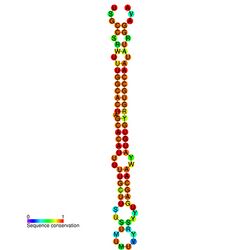Biology:mir-96 microRNA
| microRNA mir-96 | |
|---|---|
 Predicted secondary structure and sequence conservation of mir-96 | |
| Identifiers | |
| Symbol | mir-96 |
| Alt. Symbols | MIR96 |
| Rfam | RF00669 |
| miRBase | MI0000098 |
| miRBase family | MIPF0000072 |
| Other data | |
| RNA type | Gene; miRNA |
| Domain(s) | Eukaryota |
| GO | 0035068 0035195 |
| SO | 0001244 |
| PDB structures | PDBe |
miR-96 microRNA precursor is a small non-coding RNA that regulates gene expression. microRNAs are transcribed as ~80 nucleotide precursors and subsequently processed by the Dicer enzyme to give a ~23 nucleotide products. In this case the mature sequence comes from the 5′ arm of the precursor. [1] The mature products are thought to have regulatory roles through complementarity to mRNA.
miR-96 is thought to be conserved within Nephrozoa, i.e. the Deuterostomes and Protostomes. [2]
Variation within the seed region of mature miR-96 has been associated with autosomal dominant, progressive hearing loss in humans and mice. The homozygous mutant mice were profoundly deaf, showing no cochlear responses. Heterozygous mice and humans progressively lose the ability to hear. [3] [4] [5] Five genes, of 132 predicted targets, have been experimentally validated as targets of miR-96: Aqp5, Celsr2, Myrip, Odf2 and Ryk.[4]
Microarray analysis of 4-day old wildtype and mutant mice showed that in the 3′ UTR of upregulated genes, there was a significant enrichment in heptamers complementary to miR-96, implying that miR-96 normally affects a wide range of target genes, and that the mutation results in a loss of normal targets. Among the downregulated genes, there is a significant enrichment in heptamers complementary to the mutant miR-96, so the mutant miR-96 has gained novel targets.[4] Among the downregulated genes were five of particular interest; Ocm, Pitpnm1, Prestin, Ptprq and Gfi1, all of which are strongly and specifically expressed in hair cells. Mice mutant for the latter three exhibit deafness and hair cell degeneration. [6] [7] [8]

References
- ↑ "miRNPs: a novel class of ribonucleoproteins containing numerous microRNAs.". Genes Dev 16 (6): 720–728. 2002. doi:10.1101/gad.974702. PMID 11914277.
- ↑ "The deep evolution of metazoan microRNAs.". Evol Dev 11 (1): 50–68. 2009. doi:10.1111/j.1525-142X.2008.00302.x. PMID 19196333.
- ↑ "Mutations in the seed region of human miR-96 are responsible for nonsyndromic progressive hearing loss.". Nat Genet 41 (5): 609–613. 2009. doi:10.1038/ng.355. PMID 19363479.
- ↑ 4.0 4.1 4.2 "An ENU-induced mutation of miR-96 associated with progressive hearing loss in mice.". Nat Genet 41 (5): 614–618. 2009. doi:10.1038/ng.369. PMID 19363478.
- ↑ Soukup GA (2009). "Little but loud: Small RNAs have a resounding affect [sic on ear development."]. Brain Res 1277: 104–114. doi:10.1016/j.brainres.2009.02.027. PMID 19245798.
- ↑ "Prestin is required for electromotility of the outer hair cell and for the cochlear amplifier.". Nature 419 (6904): 300–304. 2002. doi:10.1038/nature01059. PMID 12239568.
- ↑ "A receptor-like inositol lipid phosphatase is required for the maturation of developing cochlear hair bundles.". J Neurosci 23 (27): 9208–9219. 2003. doi:10.1523/jneurosci.23-27-09208.2003. PMID 14534255.
- ↑ "The zinc finger transcription factor Gfi1, implicated in lymphomagenesis, is required for inner ear hair cell differentiation and survival.". Development 130 (1): 221–232. 2003. doi:10.1242/dev.00190. PMID 12441305.
Media reports
Further reading
- "VAMP8/endobrevin is overexpressed in hyperreactive human platelets: suggested role for platelet microRNA.". J. Thromb. Haemost. 8 (2): 369–378. 2010. doi:10.1111/j.1538-7836.2009.03700.x. PMID 19943878.
- "A novel locus for autosomal dominant nonsyndromic hearing loss, DFNA50, maps to chromosome 7q32 between the DFNB17 and DFNB13 deafness loci.". J. Med. Genet. 41 (2): e14. 2004. doi:10.1136/jmg.2003.012500. PMID 14757864.
- "Coordinate regulation of FOXO1 by miR-27a, miR-96, and miR-182 in breast cancer cells.". J. Biol. Chem. 284 (35): 23204–23216. 2009. doi:10.1074/jbc.M109.031427. PMID 19574223.
External links
- Page for the mir-96 microRNA precursor family at Rfam
- miRBase page for the mir-96 microRNA precursor family
- HGNC page for the mir-96 microRNA precursor family
- OMIM page for the mir-96 microRNA precursor family
- ENTREZ page for the mir-96 microRNA precursor family
 |

